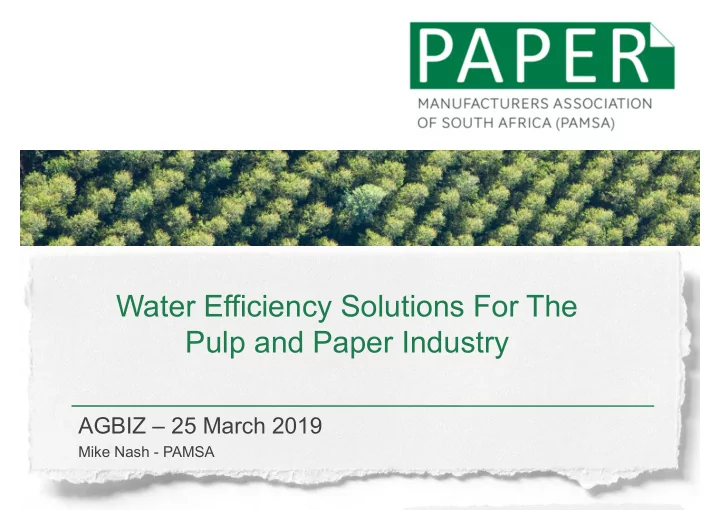

Water Efficiency Solutions For The Pulp and Paper Industry AGBIZ – 25 March 2019 Mike Nash - PAMSA
PAMSA – who we are • Represents more than 90% of paper, packaging and tissue manufacturers in South Africa. • Actively advancing the ‘story of paper’ since its foundation in 1992. • As an industry we focus on conscientious environmental stewardship, resource efficiency and innovation. • We promote active research into process innovation and the beneficiation of our bio resources and waste streams www.thepaperstory.co.za
PULP & PAPER INDUSTRY – contribution to SA Sector contribution to SA GDP 2015 2016 2017 Forestry contribution 0.49% 0.44% 0.48% to SA GDP Forestry contribution 4.21% 3.64% 4.06% to manufacturing GDP Forestry contribution 23.3% 20.1% 21.0% to agricultural GDP • Contribution of pulp and paper industry to South Africa’s national GHG emissions = 0.8% . • Average of 211,000 trees planted every day.
CARBON NEUTRAL PRODUCTS Dissolving Pulp • Clothing • Binders • Nano fibers Paper products • Printing & writing • Packaging • Tissue Bio-Streams • Bio-fuels and chemicals
FRESH WATER DEVELOPMENTS its affect on usage and environmental impact
Water Related Issues Forestry • Regulatory requirements • Water licenses – the industry relies on a number of small private and rural farmers to supply a significant proportion of its timber- each plantation needs to apply for a separate license – as there are hundreds of these entities for which the administration load is huge and costly and also tedious to obtain. • Taxes • The owners of plantations are required to pay for the rain falling on their plantations (DWAF 2003) – R2-R6/Ha/annum • Water resource management charges for plantations www.thepaperstory.co.za
Water related Issues Production plants • Both the pulping and paper making operations require significant amount of water which in integrated mills situated in rural areas is either abstracted from rivers and in urban areas from municipal supply. • Rural supply is becoming increasingly more challenging as the affects of climate change becomes more pronounced, whilst urban supply is subject to increasing cost and restrictions on supply. • Water is required in the manufacturing process generally as a final stage in washing and make-up processes • Potable water is used for the generation of steam to produce power and then as a heating medium – co-generation www.thepaperstory.co.za
Water Use Mitigation integrated water circuits • The pulping circuit is designed to minimize the use of fresh water by integrating a number of closed loops into the circuits which only requires the making up of losses associated with those from equipment or production rate changes. • Steam condensates from steam generation is returned to the boiler after demineralization processes. • Evaporator condensates are returned to the final washing stages for re-use in the closed washing circuit. • In integrated mills final treated effluent is used as an irrigation medium for pasture land and cattle farming or for plantations. • Paper circuits are optimized through advanced mathematical techniques, (pinch analysis), where intermediate streams are matched wrt. temperature and concentration www.thepaperstory.co.za to substitute fresh water usage.
Water Use Mitigation research and development PAMSA through its Process Research Unit is involved with a number local higher learning institutions to expand the industries knowledge of the latest mathematical techniques and worldwide process developments whilst also carrying out ROYALTY-FREE STOCK PHOTO fundamental research at the masters and doctorial level. In particular: • The development of mathematical algorithms applicable to particular mills to analyze complex water circuits for both thermal and chemical content through “stream matching” to optimize the use of exiting streams and reduce the need for fresh water addition to the circuit. • The treatment of water rich paper sludge effluent streams by enzymatic action to produce bio-ethanol, reducing the solid load to waste fill and enabling the recycle of the water for further use in the plant. • The development of separation techniques, (both bio and membrane based), to extract valuable chemicals and render the liquid stream available for further treatment and possible recycling. www.thepaperstory.co.za
PAMSA – questions? www.thepaperstory.co.za
THANK YOU www.thepaperstory.co.za
Recommend
More recommend